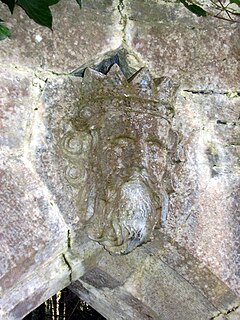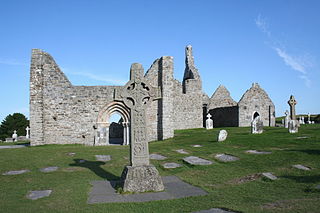
Ruaidrí mac Tairrdelbach Ua Conchobair was King of Connacht from 1156 to 1186, and High King of Ireland from 1166 to 1198. He was the last High King of Ireland. Anglo-Normans invaded Ireland. Ruaidrí was the last native and Celtic King of Ireland.

Clonmacnoise is a ruined monastery situated in County Offaly in Ireland on the River Shannon south of Athlone, founded in 544 by Saint Ciarán, a young man from Rathcroghan, County Roscommon. Until the 9th century it had close associations with the kings of Connacht.
Toirdhealbhach Mór Ua Conchobhair anglicised Turlough Mór O'Conor, was King of Connacht (1106–1156) and High King of Ireland.
Chronicon Scotorum, also known as Chronicum Scotorum, is a medieval Irish chronicle.
Toirdhealbhach Ua Briain, anglicised Turlough O'Brien, was King of Munster and effectively High King of Ireland. A grandson of Brian Bóruma, Toirdelbach was the son of Tadc mac Briain who was killed in 1023 by his half-brother Donnchad mac Briain.
The Annals of Tigernach are chronicles probably originating in Clonmacnoise, Ireland. The language is a mixture of Latin and Old and Middle Irish.
Mac Aodhagáin, is an Irish Gaelic clan of Brehons who were hereditary lawyers - firstly to the Ó Conchobhair Kings of Connacht, and later to the Burkes of Clanricarde.
Ruaidrí Ua Conchobair, called Ruaidrí na Saide Buide was King of Connacht, perhaps twice.
Conchobar mac Taidg Mór was a King of Connacht from the Uí Briúin branch of the Connachta. He was the grandson of Muirgius mac Tommaltaig, a previous king. His father Tadg Mór had been slain fighting in Muirgius' wars versus the minor tribes of Connacht. He was of the Síl Muiredaig sept of the Uí Briúin. The Ó Conchobhair septs of Connacht are named for him.

Áed Ua Crimthainn, also called Áed mac Crimthainn, was abbot and coarb of Terryglass, near Lough Derg in County Tipperary, Ireland. He was the principal scribe of the Book of Leinster, the Book of Oughaval, an important Middle Irish medieval illuminated manuscript, and is also believed to have been its sole compiler.
Áed Ua hOissín was consecrated first Archbishop of Tuam in 1152 and died in 1161. He was closely associated with Connaught royalty, and had served as abbot of Tuam.
The Abbot of Clonfert was the monastic head of the abbey of Clonfert in County Galway, Ireland. The abbey was founded by Saint Brendan in the early sixth century. The abbots also bore the title "Comarbai Brénaind", "successor of Saint Brendan".
The Abbot of Clonard was the monastic head of Clonard Abbey, which is in modern-day County Meath, Ireland. The abbey was founded by Saint Finnian in the early sixth century. After the death of Saint Finnian, the abbots bore the title "Comarbai Finnéin". However, the title was ambiguous, since it may refer to the abbots of Moville, County Down, founded by Finnian nepos Fiatach. The abbots of Clonard were sometimes called 'coarbs of Finnian and Mo Cholmóc'. Until the early twelfth century, a few of the abbots and some others at Clonard Abbey were consecrated bishops, but this did not necessarily mean they were bishops of Clonard, since the diocese of Clonard was not established until the Synod of Rathbreasail in 1111.

The Abbot of Glendalough was the head of the monastery at Glendalough, founded by Saint Kevin in the early sixth century, which is in modern-day County Wicklow, Ireland. After the death of Saint Kevin, the abbots bore the title "Comarbai Cóemgein". Until the early twelfth century, a number of abbots and others at the monastery of Glendalough had also been consecrated bishops, but this did not necessarily mean they were bishops of Glendalough, since the Diocese of Glendalough was not established until the Synod of Rathbreasail in 1111.
Áed Ua Conchobair or Áed in Gai Bernaig was the King of Connacht, and reigned from 1046 to 1067. He was the son of Tadg in Eich Gil.
Muireadhach Ua Dubhthaigh was an Archbishop of Connacht, in Ireland.
Maghnus Ua Conchobair, Prince of Connacht, died 1181.
Urard mac Coise was an Irish poet who lived in the townland of Clare, County Westmeath.
Cétadach was the 31st Abbot of Clonmacnoise. He died in 848.



